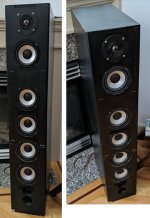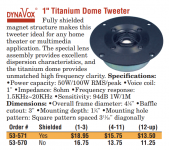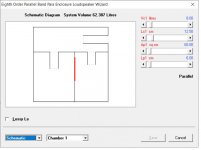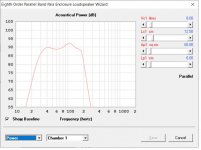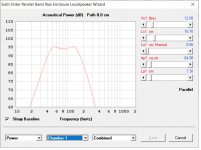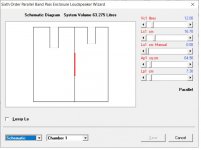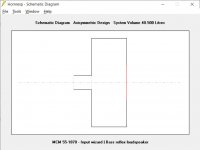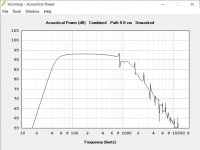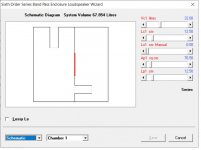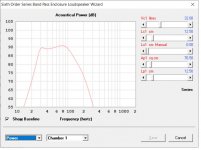I wanted to learn more about DSPs and active speakers. So I got myself an ADAU1452 board and a 6 channels TPA3116 amplifier, as a starting point. And the DSP programming part is pretty well understood at this point
Instead of buying a few random speakers online, I found a Craigslist deal and got a couple of DIY tower speakers with one tweteer and 5 midwoofers. 12 individual speakers to play with for the cost of a cheap lunch for two.
The current speakers are in a 3/4" MDF box, 8"x15"x44", no bracing, and lots of fiberglass batting insulation inside (yuck, hate fiberglass). I listened to the speakers, and pretty much hated the sound (weirdly, almost no mids, and very hot high frequencies. Granted it was a quick test and the speakers were very poorly positioned). The design and build seems very competent, and there is a pretty beefy crossover, which seems well built; the midwoofer closer to the tweeter is in its own separate enclosure, also filled with fiberglass, so I can only assume that the builder actually wanted that sound signature. To each its own, I guess. Pretty sure that the boxes will be given away, too big for my rooms anyway and even if well built, would require too much work refinishing them for any type of WAF.
So now I find myself with 10 MCM 55-1870 midwoofers (specs enclosed) and two Dynavox 53-570 tweeters (no real specs, just a frequency range and sensitivity info). Very little information on both, especially the tweeter. From what I could find, those were semi-decently regarded cheap speakers, especially the midwoofers, and the tweeter is known to have higher sensitivity at higher frequencies, resulting in less-than-linear graph. But since I plan to use a DSP and dedicated amplifier for each channel, I can correct that.
Let me say upfront that I have no expectations to end up with a good speaker. My goal is to learn, and learn as cheaply as I can, reserving the budget for better components once I know enough
At the moment the speakers I listen to the most are a pair of Paul Carmody Speedsters I built from a kit. Love those speakers, and one day I will experiment more with ribbon tweeters
I was planning to build a 3-way active speaker, with a tweeter, a midwoofer in a standalone enclosure and 2 (or 4) midwoofers as bass, with a port to help reinforce the bass. It's unclear to me if crossing over the single midwoofer differently than the 2 or 4 "woofers" will help improve the sound vs using all 5 midwoofers with similar filters. That's part of what I want to see first hand and learn. I listen mostly at low volume, and relatively close by in smaller rooms. I'm not looking for a visceral bass (I also live in an apartment, and powerful bass tends to p*** off neighbors very quickly)
But given my listening habits, I was thinking also about an open baffle design (which, incidentally, it's easier with the limited tools I have in the apartment. I used to have a decent workshop, but not anymore). Clearly with the puny midwoofers I have, a true open baffle will have no bass, so maybe an open baffle for the tweeter and one midwoofer, and the other 2 or 4 woofers in an ported enclosure.
Any suggestions? What would you do with the random set of components I have? What is worth exploring, to learn more about active speakers? I don't have enough for a linear array, even if I saw a design using 8 of my same woofers Kevin's Straight 8 Speakers (but I have no intention to buy more of those)
I think I can tame the tweeter to sound close to what I like. But maybe I should consider a real woofer (no bigger than 6-8") to complement what I have. If so, suggestions for a cheap/honest woofer to consider are welcome
P.S. If anyone local to Seattle is interested in the boxes, send me a PM. The box is pretty well done and with a different baffle can be used for quite a lot of designs. I just don't have the space to store it for the future
Instead of buying a few random speakers online, I found a Craigslist deal and got a couple of DIY tower speakers with one tweteer and 5 midwoofers. 12 individual speakers to play with for the cost of a cheap lunch for two.
The current speakers are in a 3/4" MDF box, 8"x15"x44", no bracing, and lots of fiberglass batting insulation inside (yuck, hate fiberglass). I listened to the speakers, and pretty much hated the sound (weirdly, almost no mids, and very hot high frequencies. Granted it was a quick test and the speakers were very poorly positioned). The design and build seems very competent, and there is a pretty beefy crossover, which seems well built; the midwoofer closer to the tweeter is in its own separate enclosure, also filled with fiberglass, so I can only assume that the builder actually wanted that sound signature. To each its own, I guess. Pretty sure that the boxes will be given away, too big for my rooms anyway and even if well built, would require too much work refinishing them for any type of WAF.
So now I find myself with 10 MCM 55-1870 midwoofers (specs enclosed) and two Dynavox 53-570 tweeters (no real specs, just a frequency range and sensitivity info). Very little information on both, especially the tweeter. From what I could find, those were semi-decently regarded cheap speakers, especially the midwoofers, and the tweeter is known to have higher sensitivity at higher frequencies, resulting in less-than-linear graph. But since I plan to use a DSP and dedicated amplifier for each channel, I can correct that.
Let me say upfront that I have no expectations to end up with a good speaker. My goal is to learn, and learn as cheaply as I can, reserving the budget for better components once I know enough
At the moment the speakers I listen to the most are a pair of Paul Carmody Speedsters I built from a kit. Love those speakers, and one day I will experiment more with ribbon tweeters
I was planning to build a 3-way active speaker, with a tweeter, a midwoofer in a standalone enclosure and 2 (or 4) midwoofers as bass, with a port to help reinforce the bass. It's unclear to me if crossing over the single midwoofer differently than the 2 or 4 "woofers" will help improve the sound vs using all 5 midwoofers with similar filters. That's part of what I want to see first hand and learn. I listen mostly at low volume, and relatively close by in smaller rooms. I'm not looking for a visceral bass (I also live in an apartment, and powerful bass tends to p*** off neighbors very quickly)
But given my listening habits, I was thinking also about an open baffle design (which, incidentally, it's easier with the limited tools I have in the apartment. I used to have a decent workshop, but not anymore). Clearly with the puny midwoofers I have, a true open baffle will have no bass, so maybe an open baffle for the tweeter and one midwoofer, and the other 2 or 4 woofers in an ported enclosure.
Any suggestions? What would you do with the random set of components I have? What is worth exploring, to learn more about active speakers? I don't have enough for a linear array, even if I saw a design using 8 of my same woofers Kevin's Straight 8 Speakers (but I have no intention to buy more of those)
I think I can tame the tweeter to sound close to what I like. But maybe I should consider a real woofer (no bigger than 6-8") to complement what I have. If so, suggestions for a cheap/honest woofer to consider are welcome
P.S. If anyone local to Seattle is interested in the boxes, send me a PM. The box is pretty well done and with a different baffle can be used for quite a lot of designs. I just don't have the space to store it for the future
Attachments
You'll definitely want to cross those as a three way, in my opinion. You could do three and a half way but you'd need more amplifier channels and DSP/DAC channels for that.
Three way is fairly obvious. The tweeter and top 1870 do the treble and mids with the 4 bass drivers doing the bass. Wire the top two bass drivers in series and the bottom two in series, then connect the two series strings in parallel. This will give you an 8 ohm net impedance.
Crossover with 4th order acoustic slopes between the tweeter and midrange around 2.5kHz as a starting point.
4th order will work fine for the bass to midrange crossover too but you could go second order if you wanted. Once again acoustic slopes. I'd personally go for 4th order as this will reduce lobing. I'd go with 300Hz as a starting point there.
Three way is fairly obvious. The tweeter and top 1870 do the treble and mids with the 4 bass drivers doing the bass. Wire the top two bass drivers in series and the bottom two in series, then connect the two series strings in parallel. This will give you an 8 ohm net impedance.
Crossover with 4th order acoustic slopes between the tweeter and midrange around 2.5kHz as a starting point.
4th order will work fine for the bass to midrange crossover too but you could go second order if you wanted. Once again acoustic slopes. I'd personally go for 4th order as this will reduce lobing. I'd go with 300Hz as a starting point there.
Let me say upfront that I have no expectations to end up with a good speaker. My goal is to learn, and learn as cheaply as I can, reserving the budget for better components once I know enough
If you have not already stripped the donor boxes, I would extract information first. If you can measure them (as is) you may be able to understand why you don't like them. Maybe you can improve/fix them or replace the passive XO with your DSP as a sandbox exercise before discarding the shells.
If you have not already stripped the donor boxes, I would extract information first. If you can measure them (as is) you may be able to understand why you don't like them. Maybe you can improve/fix them or replace the passive XO with your DSP as a sandbox exercise before discarding the shells.
Thanks for the suggestion. I did think about measuring the speakers, but I would need proper positioning (ideally outdoors) in order to get good enough data from REW and the UMIK-1 microphone.
And in any case, there was no hope to reuse the boxes, given how big (and ugly) those are... WAF and all that.
So I decided that measuring them was not worth the extra effort to set up everything properly
Perfect, this is exactly the type of feedback and suggestions I was hoping for. At the moment I jury-rigged only 2 of the lower midwoofers (in parallel, my amplifier can deal with 4 Ohm). I wanted to see if I can get enough bass with only 2, for size reasons (fitting 6 speakers on a single baffle will inevitably lead to a very big speaker)You'll definitely want to cross those as a three way, in my opinion. You could do three and a half way but you'd need more amplifier channels and DSP/DAC channels for that.
Three way is fairly obvious. The tweeter and top 1870 do the treble and mids with the 4 bass drivers doing the bass. Wire the top two bass drivers in series and the bottom two in series, then connect the two series strings in parallel. This will give you an 8 ohm net impedance.
Crossover with 4th order acoustic slopes between the tweeter and midrange around 2.5kHz as a starting point.
4th order will work fine for the bass to midrange crossover too but you could go second order if you wanted. Once again acoustic slopes. I'd personally go for 4th order as this will reduce lobing. I'd go with 300Hz as a starting point there.
How about a pair of closed box WTW which could me made small-ish then augment the bass with a 4 driver BPx subwoofer. Only 5 amp channels required and 2 spare drivers.
Last edited:
How about a pair of closed box WTW which could me made small-ish then augment the bass with a 4 driver BPx subwoofer. Only 5 amp channels required and 2 spare drivers.
That's an interesting idea. I also like MTM or WTW speakers, purely from a visual point of view, so well worth exploring.
I'm not sure what you mean by " BPx subwoofer" though. I mean, I get the fact that I could use 4 of the midwoofers to work as a subwoofer in a separate box. I'm not sure if BPx is a style of subwoofer or a type of enclosure
Using 2 woofers in a small closed box will have LF roll off at ~100Hz. So you'll need something to get the LF back. A BP6 can be placed against a wall or corner giving you some flexibility w.r.t location. I used BPx (BP4, BP6, BP8) as generic bandpass n-th order.
Here is a sample from Hornresp using your woofers in 2S2P BP6 series arrangement. You can import the txt file into HornResp if you want to retune the design. You will need your DSP to add subwoofer bandpass filters as well. The woofers are not ideal for this application and will not go to concert levels (Xmax limitation) but should be more than adequate for an apartment to get full sound.
Here is a sample from Hornresp using your woofers in 2S2P BP6 series arrangement. You can import the txt file into HornResp if you want to retune the design. You will need your DSP to add subwoofer bandpass filters as well. The woofers are not ideal for this application and will not go to concert levels (Xmax limitation) but should be more than adequate for an apartment to get full sound.
Attachments
Last edited:
Got it now, thanks again for not only clarifying, but also sending additional data specifically for my components. It's like having someone else doing my homework 🙂
I was not familiar a all with the bandpass enclosure, need to read more about it
I was not familiar a all with the bandpass enclosure, need to read more about it
Here is a sample from Hornresp using your woofers in 2S2P BP6 series arrangement.
Just to clarify - shouldn't "BP6 series" be "BP8 parallel"?
Thanks David, you're right it's parallel. It even says it on the diagram 🙂. When I changed the driver config to 2S2P it seems to reassign the BPx config. I just updated Hornresp and this seems to be fixed, so I'll try it again 🙂
Last edited:
@DonVK at this point I'm tempted to send you the drivers and let you build the subwoofer 🙂
I really appreciate you sharing all those designs, it's helping me a to get familiar with a subwoofer configuration I knew nothing about
I really appreciate you sharing all those designs, it's helping me a to get familiar with a subwoofer configuration I knew nothing about
Last edited:
When I changed the driver config to 2S2P it seems to reassign the BPx config.
Hi Don,
It sounds more like "operator error" to me 🙂. The selected band pass enclosure type will not change of its own accord.
Kind regards,
David
- Home
- Loudspeakers
- Multi-Way
- Looking for advice on reusing midwoofers and tweeter for active speaker
